 |
|
Vanished Scenes of Hiroshima
| |
| Before the war, Hiroshima was a city whose streets were
lined with shops and homes, and which was home to many people. In the
city center ferroconcrete buildings went up, the people's legs were augmented
by the streetcar. On holidays, theater and shopping districts were full
of people and buzzing with excitement. In spring, it was cherry blossom
viewing, in summer, the Bon Festival Dance. Each season had its own enjoyable
special events. The rivers and back streets were excellent playgrounds
for children. However, this idyllic scenery was slowly but surely lost
when the war began. Then, it vanished completely in the atomic bombing.
The entire city was engulfed in fire and turned to scorched rubble. The
injured were everywhere, and countless corpses filled the rivers and the
burned ruins. In this exhibit, city scenes from before the A-bombing are juxtaposed to the same areas or activities after the bombing. We hope this method will help you understand that there actually were people living exciting and meaningful lives in this city, and that all was lost with the dropping of the atomic bomb, some never to return. |
| Hiroshima Prefectural Industrial Promotion Hall Sarugaku-cho (now, Ote-machi 1-chome) Approx. 160m from the hypocenter In 1915, this Western-style Hiroshima Prefectural Commercial Exhibition Hall, designed by a foreign architect, appeared in Hiroshima. Its domed roof and entrance facing the river were highly innovative. It soon became a Hiroshima landmark. By the bombing, the Hall was thoroughly burned.  24 The Industrial Promotion Hall on the river Donation / Michio Fukui |
 25
25The Hiroshima Prefectural Industrial Promotion Hall engulfed in flames Drawing / Masashi Kimura Around 9:30 a.m., August 6, 1945 |
| The Camphor Trees at Kokutaiji Temple Ko-mahi (now, Naka-machi) Approx. 400m from the hypocenter On the grounds of Kokutaiji Temple, the temple (Bodaiji) of the Asano clan rulers of the Hiroshima fiefdom during the Edo era, there were four camphor trees said to be over 300 years old. The trunk of largest of these huge trees measured seven meters around. These large trees were considered natural treasures and when the streetcar tracks were laid out, they were diverted to keep the cars away from the roots of the trees. Even the sidewalk was raised. This tree was burned and reduced to this pathetic figure by the atomic bomb. The tree that withstood the A-bomb blast later died without ever putting out new sprouts. Today, it is gone. 
26 Charred camphor tree standing in the ruins Photo / Shunkichi Kikuchi Courtesy / Tokuko Kikuchi October 1945 |
 27 Huge and much-loved camphor trees Drawing / Kenichi Nakano 1912 |
| Yokobori-cho (now, Nishi-tokaichi-machi) Approx. 1,000m from the hypocenter Before the war, night stands lined the streets. Children would wander around looking at their books, candy, and other wares wondering what they should buy. For the war, there were not night stands. Ordinary civilians were killed indiscriminately by the atomic bomb. The remains of young children and the mothers that tried to protect them were found everywhere throughout the city.  28
28Night stands crowded with children Drawing / Toshiko Kihara Around 1941 |
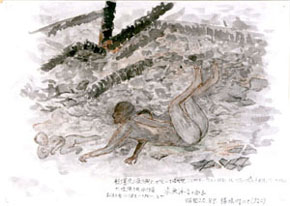 29 Charred remains of a mother and child Drawing / Goichi Nakata August 7, 1945 |
| Tenma-cho Approx. 1,300m from the hypocenter Before the war, all the main streets were linked to the old Saigokukaido Highway which, in Hiroshima, was lined with densely packed stores. Gutters ran down both sides of the street, and some were covered with wooden planks. A web of alleys ran between the main streets, many of which served as playgrounds for children. The bustling neighborhood was burned to the ground. All around lay human corpses. People came to gather and cremate the bodies, but there were so many bodies, the gruesome task continued for days.  30 Stores along both sides of the street Drawing / Shigeko Yano November 1941 |
 31 Corpses carried in on carts Drawing / Fumie Ishikawa Around noon, August 7, 1945 |
| Sumiyoshi Bridge Approx. 1,400m from the hypocenter Summer festival at Sumiyoshi Shrine was an especially huge event. The crowds were so large it grew difficult to move. People shopped at the stands set up along the roads. At night, the sky was ablaze with fireworks. Among the more fascinating attractions were the festival boats called otomonbune that came sailing up the river. After the bombing, injured people gathered on bridges to escape the fire. Some leaned on the railings, some lay right down on the street. Suffering from terrible burns, calling for help, many breathed their last there. 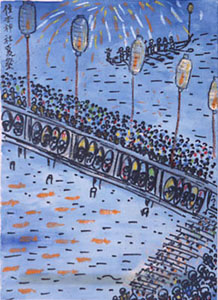 32 Bridge filled with festival spectators Drawing / Fumiko Kubota |
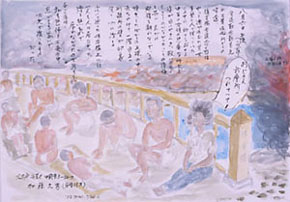 33 A bridge crowded with injured fleeing the city Drawing / Hisao Kato Before 2:00 p.m., August 6, 1945 |
| Chojuen Nishi-hakushima-cho to Hakushima-kita-machi Approx. 1,500m from the hypocenter Chojuen and the bank across the Otagawa River were planted with hundreds of cherry trees. In spring, crowds flocked here to see the blossoms. After the bombing, the injured tended to gather on riverbanks to escape the fire, so it was there that many relief stations were set up. All along the banks walked long lines of people fleeing to the outskirts. 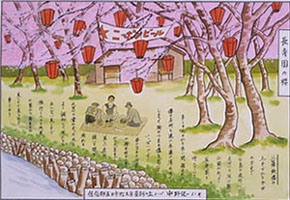 34 Cherry trees in full bloom along the river Drawing / Kenichi Nakano |
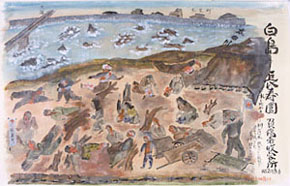 35 A place famous for cherry blossom viewing became a place of refuge for injured victims. Drawing / Yukitaka Hori August 6, 1945 |
| Near Hiroshima Station Matsubara-cho Approx. 1,900m from the hypocenter In Matsubara-cho, south of Hiroshima Station, the streets were lined with pines (matsu) giving the area its name. It was called East Matsubara to distinguish it from the pine-lined streets of Fukushima-cho. This entire area was lively with public markets, moving picture theaters, and row after row of restaurants and inns. The A-bomb instantly destroyed the lines of commercial establishments. The station itself, a ferroconcrete building of an unusual design, was engulfed in flame and gutted. Nothing but the external walls remained. However, a few days after the bombing the Sanyo and other main lines were restored, and the station became a base for the transportation of injured victims and relief workers. 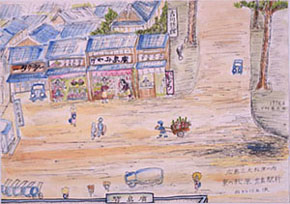
36 In front of Hiroshima Station, the streets were lined with pines and restaurants standing eave to eave. Drawing / Giso Shimomura Around 1935 |
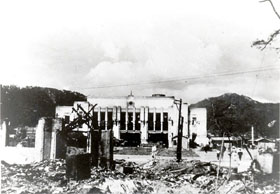 37 Hiroshima Station in ruins Photo / Toshio Kawamoto Around October 1945 |
|
A-bomb Drawings -A People's Record of Hiroshima
A-bomb Drawing Campaign Hiroshima A-bomb Survivors Vanished Scenes of Hiroshima A People's Record of Hiroshima Individuals and Group Contributors to This Exhibition Return to TOP |